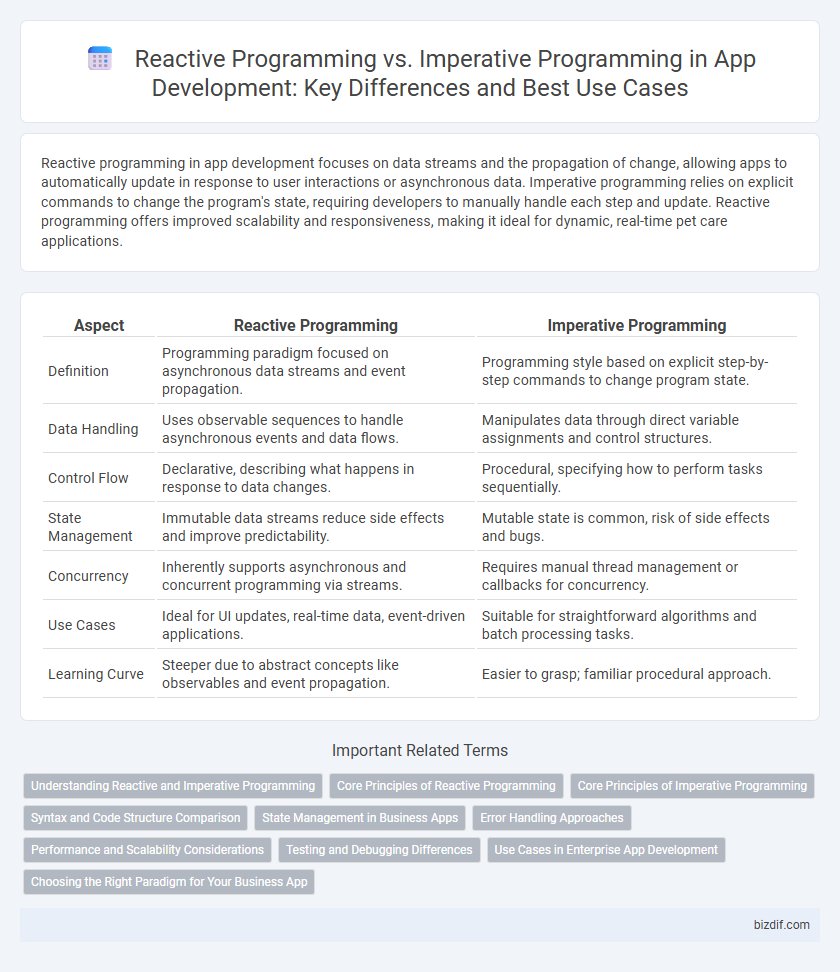Reactive programming in app development focuses on data streams and the propagation of change, allowing apps to automatically update in response to user interactions or asynchronous data. Imperative programming relies on explicit commands to change the program's state, requiring developers to manually handle each step and update. Reactive programming offers improved scalability and responsiveness, making it ideal for dynamic, real-time pet care applications.
Table of Comparison
| Aspect | Reactive Programming | Imperative Programming |
|---|---|---|
| Definition | Programming paradigm focused on asynchronous data streams and event propagation. | Programming style based on explicit step-by-step commands to change program state. |
| Data Handling | Uses observable sequences to handle asynchronous events and data flows. | Manipulates data through direct variable assignments and control structures. |
| Control Flow | Declarative, describing what happens in response to data changes. | Procedural, specifying how to perform tasks sequentially. |
| State Management | Immutable data streams reduce side effects and improve predictability. | Mutable state is common, risk of side effects and bugs. |
| Concurrency | Inherently supports asynchronous and concurrent programming via streams. | Requires manual thread management or callbacks for concurrency. |
| Use Cases | Ideal for UI updates, real-time data, event-driven applications. | Suitable for straightforward algorithms and batch processing tasks. |
| Learning Curve | Steeper due to abstract concepts like observables and event propagation. | Easier to grasp; familiar procedural approach. |
Understanding Reactive and Imperative Programming
Reactive programming models data flows and changes asynchronously, allowing applications to efficiently handle real-time updates and events by propagating changes automatically. Imperative programming relies on explicit instructions and step-by-step commands to manage application state and control flow, often requiring manual updates and state management. Understanding these paradigms is crucial for developers aiming to build responsive, scalable apps, with reactive approaches excelling in dynamic environments and imperative paradigms suitable for straightforward, sequential processes.
Core Principles of Reactive Programming
Reactive programming centers on asynchronous data streams and the propagation of change, enabling systems to respond dynamically to events in real time. Core principles include declarative data flow, where dependencies are explicitly defined, and non-blocking operations that enhance performance and scalability. This approach contrasts with imperative programming by emphasizing responsiveness, resilience, and elasticity in application design.
Core Principles of Imperative Programming
Imperative programming centers on explicit commands that change program state through statements and control structures like loops and conditionals, emphasizing step-by-step instructions. Core principles include mutable state management, sequencing of operations, and direct manipulation of variables to achieve desired outcomes. This approach contrasts with reactive programming by focusing on how tasks are performed rather than responding to data streams or events.
Syntax and Code Structure Comparison
Reactive programming employs declarative syntax that focuses on data streams and the propagation of change, making code more concise and easier to manage asynchronous events. Imperative programming uses step-by-step instructions with explicit control flow, often resulting in more verbose and tightly coupled code structures. Reactive code typically leverages observable sequences and functional operators, whereas imperative code relies on loops, conditionals, and mutable state management.
State Management in Business Apps
Reactive programming enhances state management in business apps by automatically updating the UI in response to data changes, reducing bugs and improving user experience. Imperative programming requires manual state handling, which can lead to complex, error-prone code when managing asynchronous events and user interactions. Leveraging reactive paradigms simplifies synchronization between the application state and business logic, enabling more maintainable and scalable app development.
Error Handling Approaches
Reactive programming handles errors through asynchronous streams, allowing real-time propagation and recovery without blocking the main thread. Imperative programming manages errors using try-catch blocks and synchronous control flow, often leading to nested and less flexible error handling. Reactive approaches improve resilience by separating error handling logic and enabling retry mechanisms, enhancing app stability and user experience.
Performance and Scalability Considerations
Reactive programming excels in performance and scalability by enabling asynchronous data streams and non-blocking operations, which efficiently handle high concurrency and dynamic workloads. Imperative programming, relying on synchronous execution and explicit state management, can face bottlenecks under heavy load and struggles with scaling in real-time applications. Choosing reactive paradigms enhances responsiveness and resource utilization in large-scale, distributed systems.
Testing and Debugging Differences
Reactive programming improves testing and debugging by enabling automatic propagation of data changes, making it easier to trace asynchronous data flows and detect side effects in real-time. Imperative programming often requires manual state tracking and step-by-step execution analysis, which can complicate identifying bugs due to its sequential and mutable state nature. Tools like reactive extensions (RxJS) facilitate better testability in reactive code by allowing concise simulation and verification of event streams, contrasting with imperative code's reliance on traditional unit testing methods.
Use Cases in Enterprise App Development
Reactive programming excels in enterprise app development scenarios requiring real-time data streaming, asynchronous event handling, and high scalability, such as live dashboards and financial trading platforms. Imperative programming remains effective for applications with predictable, sequential workflows like batch processing systems and traditional business logic implementations. Choosing between these paradigms depends on the complexity of data flow management and the need for responsiveness in the enterprise environment.
Choosing the Right Paradigm for Your Business App
Reactive programming excels in handling asynchronous data streams, making it ideal for business apps requiring real-time updates, scalability, and responsive user experiences. Imperative programming offers straightforward, sequential code that simplifies debugging and control flow, suited for apps with static data and simpler logic. Selecting the right paradigm depends on your app's complexity, performance needs, and whether responsiveness or explicit control is paramount.
Reactive programming vs Imperative programming Infographic

 bizdif.com
bizdif.com